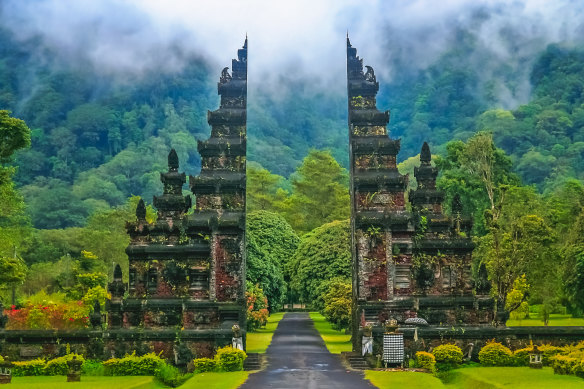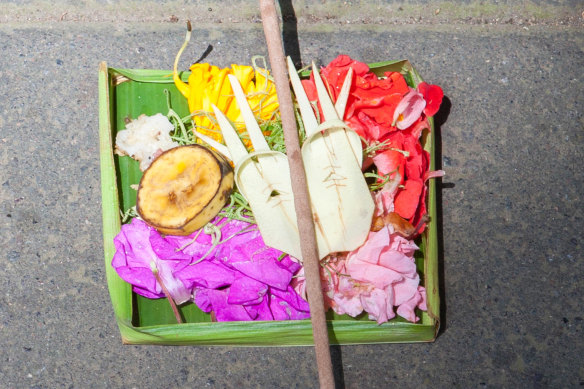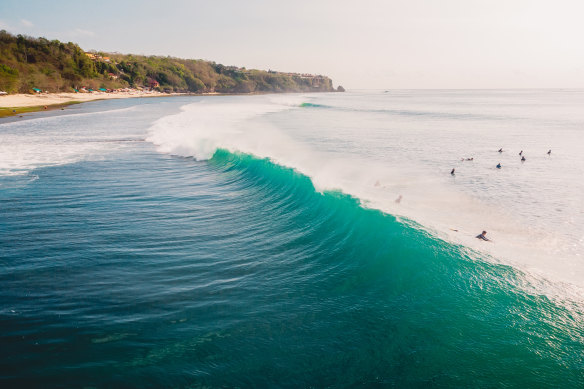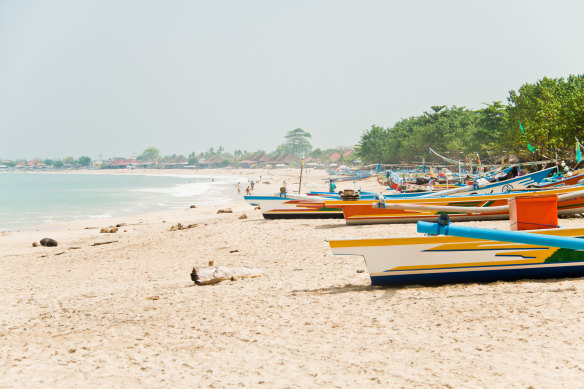This was published 7 months ago
‘My mouth fell open’: Finding the real Bali beyond the influencers
Away from the posers, lads in bucket hats and end-of-season footballers, this Indonesian island’s natural beauty astounds.
By Tim Elliott

A gate to a Hindu temple, set amid jungle. Credit: Getty Images
The first thing my wife says when we get off the plane in Bali is: “God, I love that smell.” She said this the last time we were here, in 2015, so I know that it’s not some made-up thing. And she says this as we are disembarking, when we are within spitting distance of the plane’s hulking, soot-smeared turbines, when really all we should be able to smell is avgas and the person who was sitting beside us for seven hours. But no, there it is, that signature Bali smell, a full-body olfactory embrace of incense, clove cigarettes, over-ripe fruit and flowers, laced with motorbike exhaust, rotting vegetable matter and cooking smoke. It’s quite a smell. So much of a smell, in fact, that even I, who has absolutely no sense of smell, can smell it. Or think I can.
I first went to Bali in 1985, as a 16-year-old, with my parents. Back then, I was obsessed with three things: one, the idea of perfect surf, which there was; two, the potential for marijuana growing wild, as I had been told by a mate at school; and three, cheap music. Records were still expensive at home, but in the tourist centres of Kuta and Legian there were shops selling cheap bootleg cassette tapes. For the price of one album in Sydney I could buy an entire archive of music, everything I’d ever dreamt of, at a fraction of the price. There was also, to the callow orientalist in me, the sense that Bali, with its pre-dawn mists and inscrutable gods, was a portal to the mystical East. I told myself that I would surely, like Marco Polo, come back wiser from my trip to this faraway land. That didn’t happen, but I did get a lot of new music.
I’ve returned many times since, and obviously, it’s changed. Back then, Kuta was cute, with lots of quiet alleys and family-run losmens. Sometime in the mid-1990s, however, the area ate one too many end-of-season AFL tours and mutated into the thrashing, wart-ridden hydra of consumer tourism that it is today, crawling with sloppy, sun-pinkened drunks in VB singlets and Austrian sex-tourists who got lost on their way to Bangkok’s Patpong Road. Slowly this tide oozed north to nearby Canggu, which became full of doof-doof clubs and lads from Manchester in bucket hats on MDMA.

An example of canang sari, a daily offering to the gods left by locals, which are found across the islands.Credit: Alamy
But what’s perhaps more interesting about Bali are the things that somehow, against all the odds, haven’t changed. Bali is, after all, one of the most over-touristed destinations in the world: 5.37 million people visited in 2023, down from 6.3 million in 2019 pre-COVID. This is an astonishing number considering Bali’s population is only 4.6 million. In virtually any other place, this quantity of foreigners would have long ago obliterated any trace of an indigenous culture. But not in Bali. The island’s unique brand of Hinduism is everywhere: in tiny roadside temples, in the statues at the entrance to homes, in the small shrines in the foyers of office blocks.
I put my hand to my chest. My mouth fell open. It was, indeed, breathtakingly beautiful.
Then there are the daily offerings, or canang sari, small woven bamboo baskets that hold flowers, incense, a pinch of rice, and any other random ephemera that the locals think the Gods might appreciate, like a Marlboro Ultra Light or a Mentos or a 2000-rupiah note (about 20 cents). The offerings are put out every morning and afternoon as an act of selflessness and devotion expressed in the time they take to prepare, which is not inconsiderable. You can’t miss them – they’re on doorsteps, on dining tables. In the middle of the road. On beaches. You can’t help but tread on them. Imagine: six million people treading on their culture every year, and the Balinese somehow remain equanimous about it. Indeed, they’ll often apologise that you had to tread on their offerings, as if your clumsiness was their fault.

Impossibles surf break.Credit: Getty Images/iStockphoto
Tourism has long been what Bali is about, but it’s an unforgiving business. After October 2002, when terrorists bombed two nightclubs in Kuta, killing 202 people, 88 of them Australian, foreign arrivals halved; businesses failed; workers were laid off. Tourism was just starting to rebound, in October 2005, when more bombs went off in Kuta and Jimbaran Bay. Again, tourism tanked. The national carrier, Garuda, slashed its services out of Australia while Paradise Air, which used to bring in 20,000 visitors a month, went out of business. COVID-19 was yet another disaster for Bali; international arrivals fell from about 15,000 a week to a handful. Thousands of young Balinese kids returned to their villages to grow rice, which is a whole lot less stimulating, not to mention remunerative, than practising your French on honeymooning Parisians and pocketing cash tips. But they’re survivors. And they’re patient, which is a rare thing these days.
It helps that they live in such a beautiful place. Here’s an example: for most of my life, the phrase “breathtaking view” was meaningless. Just words, like “delicious food” and “total comfort”. Then, one sunset on our most recent trip, I walked out to the edge of a cliff overlooking a surf break called Impossibles. It was my first time at this particular place but on some level, I guess I was expecting the view to be pretty good. At least above average. But when I made it to the cliff edge and looked around, and down, and out, I experienced a minor episode of beauty-induced arrhythmia, a physical shock, a little death almost, which made me gasp. I put my hand to my chest. My mouth fell open. It was, indeed, breathtakingly beautiful, and I had to immediately get a drink to calm down.

Fishing boats with painted prows line Jimbaran beach.Credit: Getty Images
There are places like that all over Bali. Viridescent valleys. Mountain lakes. The blackest sand beaches I’ve ever seen, flecked with tiny dots of twinkling mica. Mount Agung with its crown of clouds. Also, cool things: temples in the jungle, temples built into banyan trees. Beaches lined with fishing boats, each with an eye painted on its prow, so it can “see” at night. Westerners have been chasing this for decades, starting in the 1930s when artists from Europe, including Adrien-Jean Le Mayeur, Walter Spies and Rudolf Bonnet, established tiny colonies in hill towns like Ubud. (Painter and diarist Donald Friend also spent time in Bali in the 1960s and 1970s, in the beach town of Sanur, where he lived like a lord, surrounded by his gardeners, antique collection and houseboys, many of whom he sexually abused, which doesn’t fit the Bali narrative but shouldn’t be forgotten.)
These days, the artists are outnumbered by the influencers. You can spot them easily: they have peerless spatial awareness (where is the best light? Where will the best light be in four hours?) and postures like gazelles at rest. They give off a vaguely pornographic air, or at least, OnlyFans. One time, there was a big-time influencer at our hotel (the one at Impossibles) during breakfast. All the hotel guests were slobbing out in T-shirts or soggy costumes, and here she was, reeking of stealth wealth, and wearing enormous convex sunglasses that made her look like a celebrity fly. Sitting around her were several men with expensive haircuts, all competing, in a tasteful, low-key fashion, for her attention. I think they were planning some sort of shoot.
Perhaps she was advertising a product that required natural glamour. We never found out. We waited and waited for them to do something, but then we gave up. We grabbed our towels and wandered down the cliff to the water. There was a limestone cave down there which you swam through to get out to the reef, where tiny, neon-bright fish darted about like sparks. There was no one else in the water. It was truly, genuinely breathtakingly, beautiful.
To read more from Good Weekend magazine, visit our page at The Sydney Morning Herald, The Age and Brisbane Times.